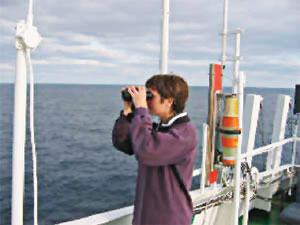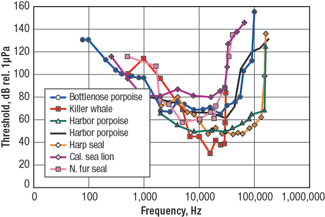Protecting the Environment
Efficacy of passive acoustic monitoring for marine mammals set to improve
Better technology means that required use regulations may spread. But whether it is necessary is still undetermined.
Perry A. Fischer, Editor
“Dolphins live together in pairs, male and female. It is not known for what reason they run themselves aground on dry land; at all events, it is said they do so at all times, and for no obvious reason.”
Aristotle wrote this in about 350 BC. At the time, no one knew why dolphins did this. Some 24 centuries later, we still don’t know. The latest theory comes from the University of Kiel, Germany, where two independent scientists published research that indicates surges in solar activity may cause whales to run aground. Solar radiation changes can significantly affect the earth’s magnetic field, and this might be disrupting the magnetic sense orientation of whales, they theorize. They compared North Sea whale stranding data from 1712 to 2003 with sunspot observations over the same period. They concluded that 90% of recorded strandings occurred during periods of increased solar activity.
But it doesn’t matter, because many biologists are already convinced that it’s somehow related to human activity. Most of the mitigation effort, useful or not, scientifically warranted or not, falls on the oil exploration seismic industry. There is significant uncertainty and debate over what levels of manmade sound are harmful to marine mammals. But, like the “mitigation community” itself, who has side-stepped whether there is actual harm done, that core issue must be set aside for now.
Of all of the mitigation effort and expense that’s been placed on the seismic industry, it’s Passive Acoustic Monitoring (PAM) that simultaneously holds the most promise to unambiguously detect marine mammals at a substantial distance, but also has a huge potential for misuse through premature deployment, without knowing its efficacy, thereby running up millions of dollars in useless expense.
 |
Marine mammal observers, now required, often do not have the good visibility conditions seen here. That’s where PAM can be most useful. From www.pamguard.org.
|
|
PAM consists of listening to marine mammal’s underwater vocalizations. With appropriate software and hardware, it might be possible to accurately identify and locate a variety of vocal marine mammals.
Current laws in many offshore oil regions require dedicated visual observers. When a marine mammal is sighted, slow startup or shut down procedures may be required. However, there are many times when poor weather or night prevents a visual sighting. Many agencies, such as the MMS in the US and the Joint Nature Conservation Committee (JNCC) in the UK strongly recommend that PAM be used, but do not yet require it. However, if startup is desired at night or in poor visibility, “ramp-up cannot begin...unless... Experimental Passive Acoustic Monitoring is used, as per MMS rules.”
In theory, PAM can determine whether marine mammals are nearby, even when they cannot be seen. There are certain instances where the distinct clicking noise patterns of a marine mammal, say, a sperm whale, can be clearly detected. PAM is very useful for detecting the general presence of these species.
The US’ MMS recently stated, “Whales, especially sperm whales, are very vocal marine mammals, and periods of silence are usually short and most often occur when these animals are at the surface and may be detected using visual observers. However, sperm whales are at the greatest risk of potential injury from seismic airguns when they are submerged and under the airgun array. Passive acoustic monitoring appears to be very effective at detecting submerged and diving sperm whales, and some other marine mammal species, when they are not detectable by visual observation. The MMS strongly encourages operators to participate in an experimental program by including passive acoustic monitoring as part of the protected species observer program.”
The present PAM technology has fundamental limits due to the difficulty of identifying particular marine mammal sounds. This difficulty is further complicated by man-made sounds and natural marine noises. Determination of range, which is an important element in deciding whether to shut down seismic operations, is even more difficult.
Thus, across the full spectrum of marine mammal sounds and, especially, for determining bearing and range, many observers feel that PAM has not yet been demonstrated reliable and useful in practice. And of course, it is useless for non-vocalizing or often-silent species, of which there are many. There have been many documented cases where marine mammals, including whales, were seen but not heard with PAM, as well as cases where they were heard, but never seen.
 |
Audiograms indicate the degree to which a particular frequency is detected by an animal. Based on the auditory thresholds of captive animals for various marine mammals. From www.pamguard.org.
|
|
MMS, for example, in its programmatic environmental impact statement for oil and gas seismic exploration in the Gulf of Mexico, includes a long list of PAM limitations: “1) Passive acoustic monitoring only works for vocalizing whales; many animals are quiet much of the time, especially when disturbed; 2) difficult to determine the range to the vocalizing animals when using a towed array; 3) cannot readily determine depth to vocalizing animals; 4) for fixed hydrophones (ship or bottom-mounted recorders, sonobuoys, ocean bottom cables), area of coverage/ detection range may be limited by noise, requiring more sensors to cover a seismic survey area; 5) requires hydrophone arrays be towed behind the survey vessel (or from an additional chase boat); 6) hydrophone performance may be affected by tow speed and the ship’s acoustic characteristics, limiting detection range; and 7) cost ramifications.”
An international workshop on PAM was held in November 2005, in Monaco. It was co-organized by LISSI-iSnS (Paris University), CNRS Chize (CEBC, France), and ACCOBAMS (Agreement on the Conservation of Cetaceans of the Black Sea, Mediterranean Sea and Contiguous Atlantic Area). The purpose of the workshop “...is to present current research on the detection and localization of marine mammals using passive acoustics. Researchers were invited to present their scientific work, to detail the advantages and drawbacks of the methods they use, and to show their recent results through a practical approach.” The conference used the last half-day to compare “all scientific methods presented using the same data set.” The data sets comprise actual sperm whale sounds recorded by the US Navy Undersea Warfare Command. Results of the conference have not been published.
The PAMGUARD research initiative aims to take protection of marine mammals to another level. The effort is being financed by the Industry Research Funders Coalition (IRFC), together with Heriot-Watt University. IFRC is an association of BHP Billiton, BP, Chevron, ConocoPhillips, ExxonMobil, Shell and IAGC – the geophysical contractor association. The goal of the initiative is to create an integrated software package for PAM. Such monitoring is to determine whether marine mammals are near ongoing seismic operations, as well as their type and range. A website has been established for the project (www.pamguard.org) to get input from users.
The initiative seeks to overcome problems of range, bearing and identification through development of modular software with open-source, publicly owned coding that is available to all PAM users. The initiative states that the software must be capable of working on multiple operating systems, and include modules for mammal detection, location, classification and sound visualization.
There presently exists commercial software in this regard, such as Ishmael, Rainbow Click and Logger. However, that is proprietary software. The PAMGUARD software goals state that it must be compatible with various in-sea equipment, including the number of hydrophones/ sensors, spacing, frequency response and range. It must also be compatible with Windows, Linux and similar platforms. The initial set of modules are to be Java-coded and comparable to existing, bench-tested modules. A preliminary V0.01a version has been released. The project is being carried out at the Ocean Systems Laboratory at Heriot-Watt University in Edinburgh.
Determining when, and if, a marine mammal has been disturbed is not an easy task. Observation of altered behavior, even just a change in swimming direction, is often all that can be determined. Yet, as is true for all intelligent creatures, marine mammals can learn and, therefore, become used to their environment, realizing that seismic vessels present them no harm, eventually ignoring them. Despite last year’s MMS Finding of No Significant Impact, mitigation efforts and scientific studies continue. The best that everyone can hope for is an accurate PAM system that can reliably locate marine mammals, so that seismic contractors can know when to shut down or start up operations, even if there is no evidence of harm, and it’s done in the name of hyper-precautionary vigilance. 
|




